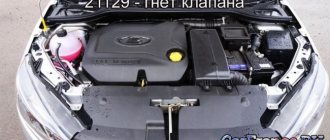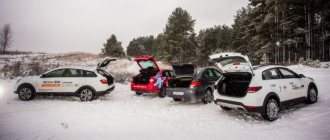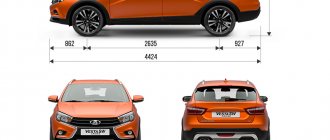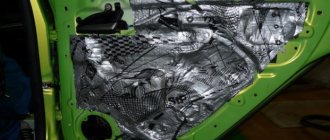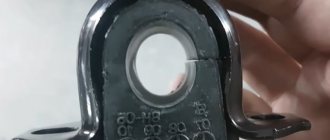Body galvanization
Body of Lada Vesta
Anti-corrosion treatment of the machine
Vesta is rightly perceived as a breath of fresh air from AvtoVAZ. They released a car with a modern design and interior, high-quality assembly and decent equipment. These are obvious improvements, but not everyone remembers whether the body of the Lada Vesta is galvanized or not. And it should, because it depends on how soon rust begins to appear on the car.
Galvanization and paintwork of Lada Vesta body
The domestic auto industry is among the TOP 30 in the production of modern class B (small cars) cars. One of the models presented by the manufacturer AvtoVAZ is the well-known Lada Vesta. After reading this article, you will understand whether the car will rust and how many years it will remain untouched by corrosion. Car enthusiasts and experts often say that when developing the Lada Vesta, manufacturers clearly set the task of “jumping above their heads.” This is evidenced by innovations that AvtoVAZ did not resort to. Including improved galvanization of the Lada Vesta body. In modern road conditions, the bodies of old cars cannot withstand the load of the environment and quickly succumb to rust. Due to global warming and climate change, road workers sprinkle the asphalt with substances that affect the metal body of the car. To prevent corrosion, a zinc protective layer is applied to the metal. The presence of a protective layer prevents the car body parts from rusting.
Let's look at the types of zinc coating. Is the body of the Lada Vesta galvanized at all? Comparison of the protective layer.
There is a myth that the Lada Vesta, like most Russian cars, has a body protected only by paintwork (paint coating). It is not true. The Lada Vesta has a zinc coating, although not the best.
4 ways to coat metal with a layer of zinc in production
Hot method – used for LUX class. When hot galvanizing, the entire finished car body is immersed in a tank with liquid zinc heated to +500 degrees. This expensive method is used by brands: PORSHE, Jaguar, Bentley, Ferrari, etc.
Cold method - Using an aerosol, a layer of powder containing zinc is applied. The process is similar to painting. This method is common; brands use it: KIA, Mitsubisi, TOYOTA, Skoda.
Galvanic method - using the application of electrically active solutions. Microparticles of zinc settle on the body under voltage. Inexpensive way.
Zinc metal is a method more often used in the production of Asian car brands, such as KIA. Two plastic zinc layers are applied to the body. Suitable for class C cars.
Is Lada Vesta galvanized?
Following Soviet tradition, manufacturers chose a cheap galvanizing method for Lada Vesta and LADA Vesta SV Cross - cold coating. It should be noted that the cars are galvanized on the outside. This galvanization is of lower quality, but is a good option for budget cars. Double-sided galvanization typical for expensive brands Mersedes, BMW, Lexus.
AvtoVAZ gives a six-year warranty on LADA Vesta. This is due to the fact that the zinc layer covering the body is 8 microns - not bad for the domestic automobile industry.
Is the Lada Vesta's paintwork reliable?
Everything is fine here. The producers outdid themselves and coped with the task. The car has passed many tests carried out by painters and ordinary car enthusiasts. This time AvtoVAZ produced a high-quality painted car. The paintwork applied to the galvanized finished Vesta body has no factory defects, underpainting or abrasions of the coating. Which pleasantly surprised fans of the VAZ manufacturer. The only thing that consumers may have questions about is the thickness of the paintwork. The point here is the established eco-standards, which provide for a small thickness of the paintwork applied to the body. Experts say this is enough. Having a coat of paint on a car like Vesta has, the owner can count on at least 7-8 years of quiet life, without fear of rust. If you look at the latest inexpensive models from Volkswagen, Ford, Skoda - all of them, having paintwork thickness that meets eco-standards, keep their shape, do not rust, and do not crumble. The same durability can be expected from the galvanized body of LADA Vesta.
Does Lada Vesta need additional anti-corrosion treatment?
Above, we have already examined the strengths of paintwork and the presence of galvanization. To answer more precisely, you need to understand what the car body is made of. Low carbon sheet steel is a component that makes up the body. Steel is prone to corrosion. If we add that the body is not completely galvanized, but is protected only from the outside, the conclusion suggests itself - factory galvanization is not enough.
During one of the test drives conducted by Russian auto experts in the first months after the release of Vesta, it was noticed that the inside of the car and especially the bottom were galvanized somehow. The car is well made, but if you look deeper, you can feel the manufacturer’s signature. There are several types of application of additional primer, which are used depending on the primary galvanizing method.
A good option would be the ML method. It involves spraying chemical compounds into car parts that form a reliable anticorrosive agent. If the machine is used carefully and minor cosmetic damage is eliminated, the machine with additional treatment will not rust for 10-12 years.
Technology for applying a protective coating to the Lada Vesta body
Considering the method used for galvanizing, a type of additional treatment suitable for the car is cataphoresis priming. This is a complex process consisting of several stages.
- Removing protective covers from the machine body;
- Removing fats from metal;
- The body is immersed in a bath of cataphoresis solution;
- Washing off the remaining solution;
- Drying cataphoretic soil.
After passing the last stage, the body has a new, tight-fitting primer layer that protects the outer parts of the body and the internal cavity.
Painting Lada Vesta
Painting of the car begins after the application of primer has been completed. Step by step, the car is prepared for the painting procedure. Since painting is done with an aerosol in several layers, robot labor is used. A solution is applied to the surface, strengthening the seams and protecting the body from corrosion. Then noise-insulating mastic is used, which adds silence to the car on the roads.
When applying primer coating with robots, many hard-to-reach places remain and have to be processed manually. The inner sides of the pillars, the edges of the roof covered with doors, are finished manually. The primer comes in two tones: light or dark. Choose depending on the color of the car.
Once the priming stages are completed, the car is sent to the next conveyor for developing the secondary layer. Here, specialists eliminate paint coating application defects and coat the seams with brushes and paste. After all the procedures, specialists, with the help of robots, proceed directly to painting the car. The paint application process is not complicated. A common aerosol spray that motorists have dealt with. A layer of varnish is applied over the paint, and the finished painted and varnished body is sent to dry, which takes an hour. The entire painting procedure lasts no more than four hours.
When the body is dried and the varnish is applied, there are a few final steps left, after which we get the product in the form in which it ends up on the market. The final touches are polishing and applying anti-corrosion. The result is a durable, galvanized body of the Lada Vesta. Let us remind you that the thickness of the car’s paintwork is higher than that of other parts of the car, which makes it reliable and resistant to changing weather conditions.
Vesta paintwork thickness
- On average 100-150 Microns throughout the bodywork;
- The thickness of the roof paintwork is 102 - 128 Microns;
- Doors 139 Micron;
- Front wing 140;
- Rear wing 144;
- Hood 104;
- Trunk lid 125.
Conclusion. Drawing conclusions let's say:
— Vesta has durable and well-protected body elements. In production, they use the cold galvanizing method, which is not the most reliable, but is used by European and Asian brands. Lada Vesta has a good layer of enamel, compared to cars produced by the AvtoVAZ plant previously. The presence of a good warranty period confirms the well-done work of the manufacturer.
Coating thickness
It is this method that is being implemented by the Russian concern. It was also borrowed from Western automakers.
Full cycle of sedan body treatment - from preparation to polishing.
Strictly speaking, cataphoresis is a chemical process based on an electrolytic reaction. The use of this technology makes it possible to attach a special substance to the metal surface as a protective layer. Like galvanizing, cataphoresis can significantly increase the metal’s resistance to corrosion.
Scheme of preparing a car for a cataphoresis bath.
At IzhAvto, where the Lada Vesta is assembled, the cataphoretic priming process is carried out according to the classical scheme:
- Thorough cleaning of the surface of body panels from oxidative film;
- Degreasing;
- Iron activation process;
- Immersion in a bath with cataphoresis solution;
- Rinse;
- Drying in a special chamber.
The bodies of Vesta and X Ray are dipped into such a container with a special solution.
After completing the preparatory activities, the Lada Vesta body, fixed on special holders, is sent to a cataphoresis bath filled with dissolved soil. Before lowering into the container, an anode is connected to the body, charging the steel with energy (negative). A cathode is connected to the bath itself, giving the soil molecules a positive charge.
The process of layering soil in a cataphoresis bath and subsequent drying.
After removing the body from the bath, it is sent for a rinsing procedure. This stage is necessary to wash away soil particles that are not attached to them from the surface of the panels. Like the preparatory steps, this process can be carried out by either immersion or spraying. The final step is drying the finished body. In the thermal chamber, the protective layer crystallizes and hardens. Once drying is complete, the body is prepared for primer application.
The method used by AvtoVAZ guarantees 100% surface treatment.
Painting Lada Vesta
It begins immediately after the completion of the cataphoretic priming process. First, the preparatory equipment is dismantled from the car, which is placed in a special container behind the car, and the paint shop is installed. This equipment allows you to open and close the doors, hood and trunk. By the way, the entire line is equipped with special emergency buttons, pressing which completely stops the conveyor.
The painting stage begins with the application of joint mastic to all joints, which increases corrosion resistance. In addition, line workers also spray anti-noise mastic, which reduces the noise level in the cabin.
After this comes the turn of applying primer. In this case, the bulk of the operation is performed by robots, but workers also have to prime the metal in places where the robots cannot reach. For the most part, these are the inner sides of the racks, the edges of the roof, covered by doors, etc. The color range of the primer is limited to only two tones - light and dark. His choice depends on the future color of the Lada Vesta.
First, a primer is applied to the body.
After priming is completed, the machines are sent via conveyor to the secondary soil processing area. In this department, employees eliminate painting defects using special paste and brushes.
At the end, the finished body is sent to polishing and the assembly line.
After drying, a few final touches remain - polishing and anti-corrosion treatment of cavities. In the latter case, plant workers, armed with special sprayers with long nozzles, fill the internal surfaces of the cavities (thresholds, pillars, etc.) with an anti-corrosion compound.
Despite the fact that the answer to the question whether the body of the Lada Vesta is galvanized or not is affirmative, someone may be wary of the thickness of the zinc coating. It is only 8 microns, which is not so much. However, such a layer should be enough to protect the car for five to six years even in the most unfavorable conditions.
- 125 microns on the trunk lid;
- 140 microns on doors;
- up to 128 microns on the roof;
- 104 microns on the hood;
- up to 144 microns on the wings of the wheel arches that are most vulnerable to rust.
For comparison, the thickness of the paintwork on most modern foreign cars is 100-150 microns. Consequently, Lada Vesta has excellent performance that meets all international standards.
Galvanizing the body of VAZ Vesta 1st generation
Other generations of VAZ Vesta
When a galvanized surface is damaged, corrosion destroys the zinc and not the steel.
| • | Complete - the car body is processed completely, including hidden and hard-to-reach cavities. | ||
| • | Partial - all joints and the most vulnerable parts of the body, sills, bottom, bottom of doors are processed. | • | Nodal connections - includes only processing of welding points, fastenings, stampings and other small parts. |
Over time, the processing process has changed. A younger car will always be better galvanized!
ON THE COFFEE GROUNDS
Alas, the manufacturer did not give any comments to the request from the editors of Za Rulem about the details of the rust problem. Therefore, we can only make assumptions, comparing the information received from some dealers and on owner forums, as well as the experience of operating the Crete in our fleet.
Judging by the fact that the service bulletin applies to machines manufactured before December 15, 2021, there is hope that the causes of the defect have been found and changes have been made to the technological chain on the assembly line. At least so far there is no information about such problems on 2021 cars. The manufacturer did not want to reveal the secret, and dealership employees only have assumptions about the causes of such a strange problem.
The actual scale is also unclear. Questionnaires on two large forums showed that about 25% of owners encountered rust. However, only 850 people took part in these votes. The collective electronic petition has not collected much either - to date, only 427 signatures. To put this into perspective, almost 22,000 Cretes were sold in 2021. Some dealers also talk about the low percentage of “sick” cars identified during the service bulletin period. That is, on paper, owners of cars manufactured before December 15, 2021 do not have much of a chance of seeing rust on the trunk lid, but still no one is immune from this.
During the debate about the nature of rust, a curious fact emerged - the uneven and in some places too small thickness of the paint layer. There are videos on the Internet where instruments show only 80 microns on the edges of body panels, as if there is no varnish. At the same time, the participants in the video confirm on calibrated probes that the thickness gauge is calibrated correctly.
The thickness of the paintwork was tested on several machines. It was not possible to see examples with indecently low 80 microns, but thin and too heterogeneous places were found. The experiment involved two Cretas from our fleet (2016 model year) and several new cars (2017), which were still waiting for buyers. In general, all participants with different body colors showed similar results.
Lada Vesta body
LADA Vesta is a compact car produced by the Russian company AvtoVAZ, which is designed to replace the slightly outdated LADA Priora. The sale of Vesta began in 2015 and continues to this day. Last year, the company released a whole line of new LADA Vesta models, including LADA Vesta Cross in a new body, Vesta CNG and others.
The main distinguishing features of this car are an increased level of safety - in this indicator, domestic models even surpassed the Ford Focus, and a stylish European design.
The body of the LADA Vesta was developed according to completely new standards for the domestic automobile industry. The car is more similar to its competitors from the European and American markets than to those models that were previously produced in Russia by AvtoVAZ.
Reliable body with high corrosion resistance
Cars from the Russian automobile industry have always had one common drawback that reduces their service life - the body is sensitive to damage and corrosion.
Specialists from AvtoVAZ decided to get rid of this disadvantage once and for all and developed a fundamentally new body, equipping it with an additional layer of protection. On many portals there is one and the same question that is asked by those who want to buy this car: “ Is the body of the LADA Vesta galvanized?” "
The answer will greatly please potential buyers. AvtoVAZ says: “Yes.” According to the manufacturer, thanks to the galvanized body, the new models will be extremely resistant to corrosion. For about 5-7 years, the car owner will not see a single trace of damage, which will significantly reduce repair costs. The manufacturer itself provides a 6-year warranty against corrosion. After this, it is recommended to carry out additional treatment of the LADA Vesta body in order to increase the service life of the car.
The method of applying the galvanized layer, alas, is the simplest - the so-called “cold method”. This is the cheapest way to increase the survivability of a car body. On LADA Vesta, absolutely the entire outer surface of the body is galvanized. At the same time, the arches, sills and bottom are treated not with zinc, but with anti-gravel, which allows the process of rotting and rust to be delayed for a long time.
Despite the fact that a significant part of the body surface is protected by zinc, free cavities still remain vulnerable. All the metal in the cavities, ventilated and covered with casing, will not be able to last long unharmed. Therefore, the manufacturer decided to additionally protect the metal by applying primer to the internal cavities.
Body thickness (paintwork) of LADA Vesta
During the production process, the manufacturer applies four layers to a sheet of metal: varnish, paint, primer and zinc. The first three are simply called by the abbreviation LKP. When buying a car, you must always have information about the thickness of the paintwork and zinc, because the survivability of the body and, consequently, its service life depend on these indicators.
As for the LADA Vesta car, these indicators are as follows:
- trunk lid – 125 microns;
- doors – 140 microns;
- roof – up to 128 microns;
- hood – 104 microns;
- the wheel arch wings have the highest protection – up to 144 microns.
As for the thickness of zinc, the figure here is quite low - only 8 microns and this is in the most well-protected places. And yet, such a thickness is quite enough for the body to resist corrosion for at least 5 years in the worst operating conditions.
To slightly compare the degree of corrosion protection of LADA Vesta with other cars, you should know that most modern cars have a layer of 100 to 150 microns. Thus, we see that a domestically produced car fully meets international standards.
Body color of LADA Vesta
When buying a car, you should always pay attention to the color of the body. In the case of LADA Vesta, we have a difficult choice, because the manufacturer produces its products in ten shades. There was also information on the network that AvtoVAZ is planning to increase the color range soon, but for now we have what we have.
All coverage options vary in cost. The “glacial” coating option is the only free color in the palette. The most expensive option (about 18 thousand rubles) is “Carthage”. Here you pay for your car to always stand out on the road and attract the attention of others. The rest of Vesta's body colors will cost the buyer only 12 thousand rubles.
What is galvanized and what is not
You can list VAZ models in increasing order of galvanized area:
- Granta sedan – minimum galvanized parts;
- Granta liftback - the same as in the sedan, plus a fifth door and wings;
- Kalina 2 - all parts except the hood, roof, front and rear side members;
- X-Ray - the entire external surface, but the roof is not galvanized;
- Vesta is the entire outer surface. The bottom, sills and arches are additionally treated with anti-gravel;
- Priora - double-sided galvanization (after 2009).
The reader probably already understands whether the body of the Lada Vesta is galvanized. Different galvanizing schemes are used for different models. The GM concern, for example, adheres to the same ideology as VAZ.
This is how the Chevrolet Lacetti sedan is galvanized
Zinc is applied from the outside, covering a significant part of the surface. For Priora, the scheme looks more solid.
Part 3 – floor screen
LADA VESTA body – galvanized or not? Subtleties of painting and protection
A lot of controversy has been caused about the modern AVTOVAZ car, which is VESTA. Many do not believe our automobile industry and say that “modern generation” is nothing more than a continuation of the “folk” GRANT, KALINA, PRIOR on the one hand. If we put aside everything else (technical and design), opponents of the brand, often entering into disputes, bring up the following facts - “ it will rot in a couple of years if not treated correctly ”! However, the manufacturer gives a guarantee “for 6 years” specifically on the body, that there will be no signs of through corrosion. And now the concept of “galvanization” begins to blow, opponents will again say that it simply isn’t there (this is a LADA, NOT a MERCEDES), others say that it is there and that the parts are reliably protected. So where is the truth? Today we’ll sort it out whether it’s there or not...
Starting the article, I would like to quote the words of one “mega-expert” from a specialized forum (I will not rewrite it verbatim), but this is the meaning. There used to be VAZ 2101s - the metal was of high quality, that’s why it didn’t rot! But now I don’t understand why, that’s why they cover it with all sorts of crap – “anti-corrosion”, “galvanization” and so on. I would like to immediately object to him, these methods are responses to modern road conditions. Previously, when “KOPEYKA” appeared, there were very few cars, I remember the winters - the snow from the roads was practically not cleared (only the main highways), there were no reagents. And what now - the roads, even at minus 10, are somehow wet, all because they are simply covered in reagents that corrode snow and ice, respectively, the body, paint and even tires (and what can I say, sometimes even boots don’t work for the season). Under such conditions, the entire “2101” would have rotted in a couple of years! So they protect modern cars, in a modern way, excuse the tautology.
Four types of technologies
A little about why zinc (Zn) protects steel - it is a non-ferrous metal, has a more negative potential and corrodes first (that is, when it collapses, it protects the coating underneath), and the protection works even when it is damaged or partially destroyed.
To apply particles of protective metal to the body, there are only four main technologies, I will list them from best to worst.
Hot method: When a fully assembled body is dipped into a bath filled with zinc. Moreover, the temperature stays around 460 – 500 degrees Celsius. The method is very expensive and costly. Used by expensive brands on luxury cars - PORSHE, VOLVO, now on some premium HYUNDAI, etc.
- Galvanic method. The method consists in the process of deposition on the cathode (in our case, part of the body), positively charged particles (ions) of zinc from aqueous solutions (electrolytes). This technology works by passing a direct electric current through it. This is a less expensive and simpler technology, used by Mercedes, BMW, TOYOTA, Honda, Mitsubishi, KIA, etc.
- Zinc metal. Used mainly by KIA, on cars from the “C” class. This is a kind of plastic coating that consists of two layers.
- Cold method. In essence, this is a kind of painting. A powder is applied to the body parts, which contains small particles of zinc powder. Used by many brands (Chevrolet, KIA, HYUNDAI, TOYOTA) including AVTOVAZ.
As you understand, VESTA is processed using the third technology; you choose where and in what volume to apply this layer.
This is where the disadvantages appear, namely the uniformity and thickness of the coating. It is also worth remembering that this layer is not 100% corrosion protection; it needs to be further strengthened.
Is the Lada Vesta body galvanized?
Vesta is rightly perceived as a breath of fresh air from AvtoVAZ. They released a car with a modern design and interior, high-quality assembly and decent equipment. These are obvious improvements, but not everyone remembers whether the body of the Lada Vesta is galvanized or not. And it should, because it depends on how soon rust begins to appear on the car.
Why is galvanization needed and what is it?
Paintwork is not enough to protect the body. The slightest damage and moisture does its job, causing oxidation of the steel. The corrosion center, unnoticeable at first, grows, and the car has to be repaired.
One of the most effective ways to prevent rust formation is galvanizing the body. Auto industry leaders have been practicing this procedure for many years. Thanks to this, they can provide a warranty on the body for up to 20 years.
How does the box synchronizer work?
Having examined the design of the gearbox synchronizer and its components, we can now study the principle of operation of this part in the gearbox. If the car is stationary or moving in one gear, the synchronizer is in the neutral position.
When the driver changes speed, the synchronizer clutch, under the influence of the fork, moves along the splines towards the input shaft gear. The clutch cotters also move and act on the locking ring, pressing it against the gear cone so that friction occurs between them.
After this, the ring rotates in the opposite direction and the coupling splines, moving forward, engage with the gear crown, due to which the primary and secondary shafts are rigidly connected to each other. As you can see, when a gear is engaged, a whole sequence of actions occurs in the synchronizer, but in practice all this happens in a split second.
Are Lada Vesta and XRAY galvanized - official information
Previously, we talked about whether the body of LADA cars is galvanized or not. In this article we would like to dwell in more detail on the Lada Vesta and Lada XRAY cars. Which parts of the body are galvanized and which are not. All data from official sources.
AvtoVAZ information
The following information is indicated on the official LADA website:
- Lada XRAY: double-sided galvanization of external body panels. Anticorrosive underbody and hidden body cavities.
- Lada Vesta: external body panels are galvanized, and a durable anti-gravel coating is applied to the sills and bottom.
The Lada Vesta presentation slide indicates that the front parts are made of high-quality double-sided hot-dip galvanized sheet metal.
The underbody of the car and wheel arches are treated with an anti-corrosion compound, forming a durable protective film that is resistant to moisture and temperatures typical of Russian climatic zones.
A special anti-gravel treatment of the body sills and hot treatment of the internal hidden cavities of the body with a protective wax-oil composition were used.
Anti-corrosion resistance is confirmed by tests in a salt spray chamber and road tests.
Information from MMK
AVTOVAZ is one of the largest partners of MMK (Magnitogorsk Iron and Steel Works). Since 2015, MMK has been conducting pilot and industrial supplies of cold-rolled and hot-dip galvanized coils made of high-strength steel grades for external and internal parts of LADA Vesta and LADA XRAY.
On the official website of MMK you can easily check what type of products are used for internal and external body parts.
External details
:
- Front right-left fender - galvanized steel
- External right-left side panel - galvanized rolled steel
- External rear right-left door panel - galvanized steel
- External hood panel - galvanized steel
- Roof panel - cold-rolled roll
- External trunk lid panel - galvanized steel
- External front right-left door panel - galvanized steel
Internal details:
- Rear wheel arch inner right-left - cold-rolled roll
- Rear wheel arch, outer right-left - galvanized steel
- Engine mudguard - galvanized steel
- Rear right floor spar - cold-rolled roll
- Floor spar middle right-left - cold-rolled roll
- Front panel extension - galvanized steel
- Front tunnel cover - cold-rolled roll
- Rear panel - cold-rolled roll
- Rear right-left door inner panel - cold-rolled roll
- Inner hood panel - cotton roll
- Internal trunk lid panel - cold-rolled roll
- Lower wind window frame panel - cold-rolled roll
- Roof crossbar - cold-rolled roll
- Rear panel cross member - galvanized steel
- Floor cross member under the rear seat - cold-rolled roll
- Front panel cross member - cold-rolled roll
- Connector of the front spar to the floor right-left - cold-rolled roll
- Front right-left sill and side member connector - galvanized steel
- Right-left floor threshold connector - galvanized steel
- Floor tunnel - cold-rolled roll
- Upper front spar reinforcement - cold-rolled roll
- Front floor reinforcement right-left - cold-rolled roll
- Front panel - cold-rolled roll
Modern sedan from AvtoVAZ
Lada Vesta SV cross volume. technical characteristics of Lada Vesta sw cross. ground clearance of Lada Vesta SV Cross
In November 2015, sales of the first car in the Lada Vesta line, a sedan, began. Its design solutions are based on the V/S platform, developed by AvtoVAZ in 2010. It was used at the Lada Silhouette concert. The technical part was finalized by Renault-Nissan specialists, which led to the introduction of a foreign steering wheel with an electronic amplifier, a radiator, electrical equipment, and a rear suspension beam into the car. In terms of size, this model is compared to the Polo sedan from Volkswagen. The new car is equipped with a VAZ-21129 engine with 106 hp. and a volume of 1.6 liters with a Renault manual transmission or a gearbox of its own production. And from mid-2016, the sedan will be produced with the Nissan HR 16 engine, which has 114 hp and a volume of 1.6 liters, currently installed on the Nissan Sentra.
The sedan has several versions: Classic, Comfort, Luxe. The simplest Classic received an estimate of 514 thousand rubles. It is equipped with an airbag for the driver's seat, stabilizers, an on-board computer, front electric windows and power steering. The Comfort version costs from 570 thousand rubles and, in addition to the previous configuration, includes airbags and heated front seats, air conditioning, an audio system, electric mirrors and rear parking sensors. The Luxe sedan version is priced at 609 thousand rubles, which additionally includes rear electric windows, rain and light sensors, a heated windshield, alloy wheels and foglights, and for an additional fee a multimedia system with a touch screen, a navigator, and a camera providing rear view is provided. , and a cruise control device.
Does cold galvanizing protect
Galvanizing cars manually When carrying out a crash test, good results were obtained. The painted part (car hood) was scratched and placed in a room with a high humidity saline solution. They stood for some time, which in real conditions corresponds to four years of operation.
The test revealed no corrosion damage. The manufacturer has achieved good results when painting cars, but for better preservation of the paintwork, it is additionally coated with cataphoresis primer, which has good adhesion to zinc.
Features of car painting
The procedure for processing the outside of the case includes a number of steps:
- Layer of zinc composition.
- Cataphoresis type soil.
- Polyester primer.
- Enamel.
- Varnish composition.
How reliable is the galvanized body of the Lada Vesta? The thickness of the coating formed by manufacturers reaches 150 microns. Therefore, metal elements are not covered with rust and corrosion stains. Manufacturers provide a warranty on the body and other elements of the vehicle.
On the inside, manufacturers apply a primer and a layer of paint. After all, in the process of moving, small pebbles and sand get on the inside. If there is no protective layer, the likelihood of rust increases.
